If you were expecting some kind of sun sign nonsense, forget about it. This is real astrology for the real world. If it's real astrology for yourself that you want, you can get it by phone or in print. And if you need help deciphering the astrological glyphs in the graphics accompanying this article, see Astroglyphs: Astrological Symbols Guide. Please note: this forecast is expressed in terms of Universal Time (UT).
What lies behind us and what lies before us are tiny matters compared to what lies within us.
-- Ralph Waldo Emerson
 For a month without SuperMoons or eclipses, December shapes up as surprisingly active on the storm and seismic front. The reason, in a word, is declination - as in lunar declination, how far above or below Earth's equator the Moon will reach in its monthly cycle. Every month, Luna traces a path in the sky that swings from above (north of) to below (south of) Earth's equator. This distance above and below is measured in degrees of declination, and over its 18.6-year cycle the maximum value ranges from a low of about 18° to a high of nearly 29°. Years when there's an extreme maximum lunar declination tend to have extreme seismic and meteorological disturbances, and as I indicated last year, we're in one now.
For a month without SuperMoons or eclipses, December shapes up as surprisingly active on the storm and seismic front. The reason, in a word, is declination - as in lunar declination, how far above or below Earth's equator the Moon will reach in its monthly cycle. Every month, Luna traces a path in the sky that swings from above (north of) to below (south of) Earth's equator. This distance above and below is measured in degrees of declination, and over its 18.6-year cycle the maximum value ranges from a low of about 18° to a high of nearly 29°. Years when there's an extreme maximum lunar declination tend to have extreme seismic and meteorological disturbances, and as I indicated last year, we're in one now.
 This year's record-breaking hurricane season surpassed a mark last set in 1933 - another year of high lunar declination maxima (averaging over 28°), and also the year of the killer California quake that long ranked near the top on the list of most expensive natural disasters in American history. We've been in the red zone since 2004, with lunar declination maxima over 27.5° since the spring of that year. We won't even hit the absolute peak of the current cycle (28.7°) until spring and fall of 2006, although we were just a hair from it in late summer and early fall of 2005. With extremes still in excess of 27.5° through the summer of 2008, we'll be years getting back to what passes for normal in terms of storm and seismic disturbances. Especially when coupled with other lunar factors - from garden variety new and full moons to eclipses, SuperMoons and perigees (the Moon's closest approach to Earth) - these lunar declination extremes mean that even ordinary seismic and meteorological disturbances tend toward the extraordinary, not only this month but for the next couple years or so.
This year's record-breaking hurricane season surpassed a mark last set in 1933 - another year of high lunar declination maxima (averaging over 28°), and also the year of the killer California quake that long ranked near the top on the list of most expensive natural disasters in American history. We've been in the red zone since 2004, with lunar declination maxima over 27.5° since the spring of that year. We won't even hit the absolute peak of the current cycle (28.7°) until spring and fall of 2006, although we were just a hair from it in late summer and early fall of 2005. With extremes still in excess of 27.5° through the summer of 2008, we'll be years getting back to what passes for normal in terms of storm and seismic disturbances. Especially when coupled with other lunar factors - from garden variety new and full moons to eclipses, SuperMoons and perigees (the Moon's closest approach to Earth) - these lunar declination extremes mean that even ordinary seismic and meteorological disturbances tend toward the extraordinary, not only this month but for the next couple years or so.
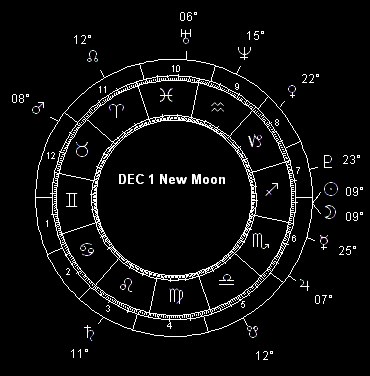 The new moons at the beginning and end of December are within a day or two of the south lunar declination peaks for the month; while the full moon on the 15th is within a day of the north lunar declination extreme. All three peaks are in the 28.5° range, so they're very near the uppermost end of the scale. All this amplified lunar torque on our home planet, in combination with Earth coming up on its perihelion (annual closest approach to the Sun) near the end of the month, makes for some sharply pronounced peaks in geocosmic stress at the beginning, middle and end of December. You'll see it in the headlines: strong storms, moderate to severe earthquakes (Richter 5 and up), and volcanic activity. This isn't some end of the world Apocalypse, mind you - but that's no consolation to someone caught in the crosshairs of a powerful earthquake or raging storm.
The new moons at the beginning and end of December are within a day or two of the south lunar declination peaks for the month; while the full moon on the 15th is within a day of the north lunar declination extreme. All three peaks are in the 28.5° range, so they're very near the uppermost end of the scale. All this amplified lunar torque on our home planet, in combination with Earth coming up on its perihelion (annual closest approach to the Sun) near the end of the month, makes for some sharply pronounced peaks in geocosmic stress at the beginning, middle and end of December. You'll see it in the headlines: strong storms, moderate to severe earthquakes (Richter 5 and up), and volcanic activity. This isn't some end of the world Apocalypse, mind you - but that's no consolation to someone caught in the crosshairs of a powerful earthquake or raging storm.
I'm sure we'll see far worse in the next several months. One reason is the current cycle of extreme lunar declination peaks, of course: it won't be going away anytime soon, as noted. But on top of that, there's the string of SuperMoons and eclipses in January, February and March. So while December isn't in the same geocosmic stress category as the SuperMoons and eclipses of this past summer and fall, and those to come in early 2006 . . . still, there's enough celestial activation around and about in December to warrant taking some prudent precautions.
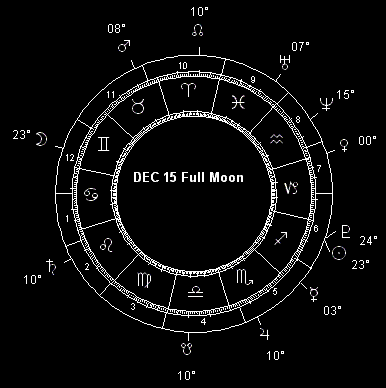 Accordingly, the geocosmic stress windows this month point to several cycles of heightened potential for strong storms as well as moderate to severe earthquakes (Richter 5 and up) and volcanic eruptions. With the new moon at 9° 32' Sagittarius on the 1st, the Moon's south declination peak (23°S25') on the 3rd, and the lunar perigee on the 5th, the whole December 1-6 period appears to be one of elevated storm, tide and seismic risk; most especially from the 1st through the 4th. A cycle of slightly elevated risk extends a day either way of the Moon's northward equatorial crossing on the 9th. Far more ominous looking is the geocosmic risk window from the 12th through the 18th, associated with the full moon on the 15th at 23° 48' Gemini and the lunar south declination maximum (28°N23') on the 16th. The Moon's southward crossing of the celestial equator on the 23rd points to brief period of elevated storm, flood and seismic potential, from the 22nd until early on the 25th. The month ends with another period of major turbulence, extending from the 28th on into early January - until early on the 7th, due to a combination of factors, including the lunar south declination maximum (23°S23') on the 30th and the full moon at 9° 32' Capricorn on the 31st, as well as the lunar perigee on January 1 and the Moon's northward equatorial crossing on the 5th.
Accordingly, the geocosmic stress windows this month point to several cycles of heightened potential for strong storms as well as moderate to severe earthquakes (Richter 5 and up) and volcanic eruptions. With the new moon at 9° 32' Sagittarius on the 1st, the Moon's south declination peak (23°S25') on the 3rd, and the lunar perigee on the 5th, the whole December 1-6 period appears to be one of elevated storm, tide and seismic risk; most especially from the 1st through the 4th. A cycle of slightly elevated risk extends a day either way of the Moon's northward equatorial crossing on the 9th. Far more ominous looking is the geocosmic risk window from the 12th through the 18th, associated with the full moon on the 15th at 23° 48' Gemini and the lunar south declination maximum (28°N23') on the 16th. The Moon's southward crossing of the celestial equator on the 23rd points to brief period of elevated storm, flood and seismic potential, from the 22nd until early on the 25th. The month ends with another period of major turbulence, extending from the 28th on into early January - until early on the 7th, due to a combination of factors, including the lunar south declination maximum (23°S23') on the 30th and the full moon at 9° 32' Capricorn on the 31st, as well as the lunar perigee on January 1 and the Moon's northward equatorial crossing on the 5th.
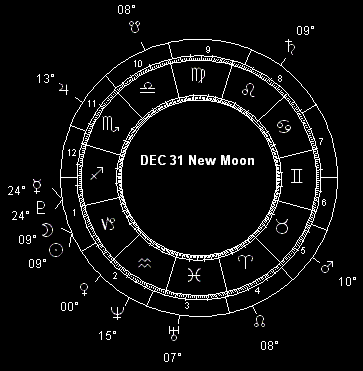 All in all, the big three geocosmic stress indicators for December fall at the beginning, middle and end of the month; with the potential for the most dangerous storm and seismic extremes within a few days of these points in time. High winds, heavy precipitation, severe electrical storms and flooding (tidal as well as inland) are part and parcel of this, along with subsequent secondary effects such as power outages, transportation delays and tie-ups (some due to weather-related crashes), and storm damage to structures and infrastructure. Since none of this can be prevented, it behooves us all to plan accordingly. So check your emergency kit, replenish as needed, and be prepared - particularly around the indicated dates. Far better to have batteries, candles, water, canned goods and such that you won't use than to need them and not have them. If traveling, or meeting someone who is, remember that weather related delays may be unavoidable during the risk windows mentioned. And don't forget that the human psyche is subject to some emotional instability during these periods as well - hysteria and depression are different sides of the lunatic coin, and there's no one who's completely immune to these tides of feeling and instinct.
All in all, the big three geocosmic stress indicators for December fall at the beginning, middle and end of the month; with the potential for the most dangerous storm and seismic extremes within a few days of these points in time. High winds, heavy precipitation, severe electrical storms and flooding (tidal as well as inland) are part and parcel of this, along with subsequent secondary effects such as power outages, transportation delays and tie-ups (some due to weather-related crashes), and storm damage to structures and infrastructure. Since none of this can be prevented, it behooves us all to plan accordingly. So check your emergency kit, replenish as needed, and be prepared - particularly around the indicated dates. Far better to have batteries, candles, water, canned goods and such that you won't use than to need them and not have them. If traveling, or meeting someone who is, remember that weather related delays may be unavoidable during the risk windows mentioned. And don't forget that the human psyche is subject to some emotional instability during these periods as well - hysteria and depression are different sides of the lunatic coin, and there's no one who's completely immune to these tides of feeling and instinct.
There are a number of other cycles at work this month, remarkable in their own right but also in terms of their potential to complicate the storm, flood and seismic developments underway. One of these is the Mercury intersolar phase, which began when the little Sun-grazer reached its maximum elongation east of the Sun on November 3 (the same day as Venus). This puts both planets at the start of their intersolar period, when they're on the same side of the Sun as Planet Earth and relatively near us. It's when these two faster inner planets catch up to Earth and then pass us on the inside track, as it were. For Mercury, this phase lasts until December 12, the day of the little planet's greatest elongation west of the Sun.
 During Mercury's November 3 - December 12 intersolar phase -including its November 14-December 4 retrograde cycle - all things Mercurial are in high focus. They're critical, essential, foremost and crucial: intelligence, wit, focus, communication, coordination, dexterity and speed are at a premium. Live and plan accordingly, and you're in a position to make the most out of whatever situation or experience comes your way during this cycle. Otherwise, you'll end up feeling like you're on the wrong side of Murphy's Law. Failure to pay attention and exercise due diligence will inevitably prove to be the worst possible thing imaginable during this kind of Mercury cycle. So stay focused, think things through, double-check everything. Take nothing for granted, and plan on just about everything that isn't watched like a hawk will run off-track.
During Mercury's November 3 - December 12 intersolar phase -including its November 14-December 4 retrograde cycle - all things Mercurial are in high focus. They're critical, essential, foremost and crucial: intelligence, wit, focus, communication, coordination, dexterity and speed are at a premium. Live and plan accordingly, and you're in a position to make the most out of whatever situation or experience comes your way during this cycle. Otherwise, you'll end up feeling like you're on the wrong side of Murphy's Law. Failure to pay attention and exercise due diligence will inevitably prove to be the worst possible thing imaginable during this kind of Mercury cycle. So stay focused, think things through, double-check everything. Take nothing for granted, and plan on just about everything that isn't watched like a hawk will run off-track.
More than half of humanity will be oblivious to these mandates, and you'll eat their lunch. You'll know it from the headlines: infrastructure breakdowns (including computers and computer networks, as well as outages in power, communication and transportation systems); also strikes and weather interruptions (including geomagnetic storms), human error and in some cases intentional mischief disrupting electrical and electronic systems (e.g. viruses, hacker attacks, and Operating System flaws causing computer and network disruptions), business and financial schemes that seem clever yet threaten good order (somebody double-check the books and the reserves!), overburdened and under-equipped educational institutions in disarray . . . themes like these are a constant undercurrent during Mercury's intersolar phase, and especially around the 5th, 10th and 12th of December. Plan for them, have your workarounds and fallback positions ready, and you'll make headway regardless - even if it is two steps forward and one back. And remember that the weather disruptions I mentioned earlier are likely to be aggravated by poor planning, systems breakdowns and the like during the first half of the month, while Mercury remains intersolar. (Disaster warning and response will leave more than a little to be desired, as well.)
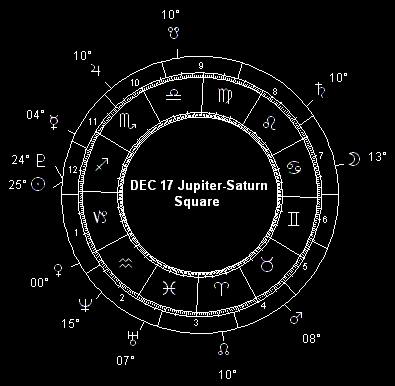 The real story in December is not so much what Mother Nature throws at us - although that certainly complicates things - as it is what we have brought upon ourselves. The historic Saturn-Jupiter-Neptune T-Square in Leo-Scorpio-Aquarius - the first of its kind in nearly 1,500 years - won't really close in until next year, but it will be casting some long and strong shadows before it this month. For one thing, Jupiter in Scorpio will move to its first exact square (90 degree arc) to Saturn in Leo on the 17th. (The Jupiter-Saturn square is one of the three elements of this T-square.) And from Taurus, Mars will oppose Jupiter on the 5th (retrograde); and then move to its second square with Saturn on the 28th - the first having been on November 18. The Red Planet's opposition and square to two of the three planets in the historic T-square fires up the configuration in advance, feeding into it in a way which, as US Secretary of Defense Donald Rumsfeld so often says, is "unhelpful." And then there's Venus moving into Aquarius on the 15th - the other sign of the T-square. Add it all up, and it's a snowball just starting to roll at the crest of the hill, all its energy in potential, its momentum just barely perceptible at first.
The real story in December is not so much what Mother Nature throws at us - although that certainly complicates things - as it is what we have brought upon ourselves. The historic Saturn-Jupiter-Neptune T-Square in Leo-Scorpio-Aquarius - the first of its kind in nearly 1,500 years - won't really close in until next year, but it will be casting some long and strong shadows before it this month. For one thing, Jupiter in Scorpio will move to its first exact square (90 degree arc) to Saturn in Leo on the 17th. (The Jupiter-Saturn square is one of the three elements of this T-square.) And from Taurus, Mars will oppose Jupiter on the 5th (retrograde); and then move to its second square with Saturn on the 28th - the first having been on November 18. The Red Planet's opposition and square to two of the three planets in the historic T-square fires up the configuration in advance, feeding into it in a way which, as US Secretary of Defense Donald Rumsfeld so often says, is "unhelpful." And then there's Venus moving into Aquarius on the 15th - the other sign of the T-square. Add it all up, and it's a snowball just starting to roll at the crest of the hill, all its energy in potential, its momentum just barely perceptible at first.
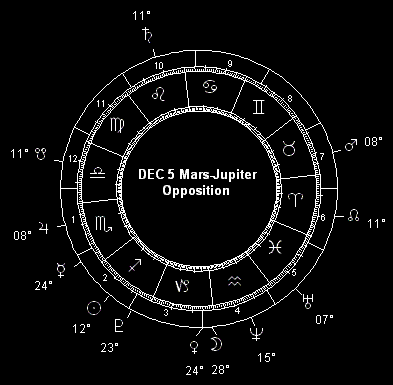 This has been building for years now. Neptune's current sojourn in Aquarius - the first leg of the tripod - began back in 1998, during the dot-com craze (when the Nasdaq first crossed 2,000) and Russia's ruble collapse and debt default. The next threshold was reached on April 12, 2003 (the day Neptune moved to within five degrees of the place it occupies when the first Saturn-Neptune opposition in the triplet occurs): the SARS outbreak, the first human cases of H5N1 Bird Flu, Gulf War II, the worst week in US tornado history. Next up was Saturn's slide into Leo on July 16, 2005: two of the three planets in the T-square had moved into the requisite signs, as the Atlantic hurricane season was on its way to becoming the worst on record (including Hurricane Katrina, the costliest and deadliest natural disaster in US history and the immediate cause of the US federal government being overwhelmed on its home turf); and the US real estate bubble was topping off, threatening the dollar-denominated global financial system. The last major piece of the tripartite puzzle fell into place as Jupiter moved into Scorpio in October, 2005 - the month of the monstrous earthquake in the Pakistan-Kashmir-India region, which killed nearly 100,000 people; as well as the uprising in France and the late season Hurricane Wilma that pounded Cuba, Cancun and Florida.
This has been building for years now. Neptune's current sojourn in Aquarius - the first leg of the tripod - began back in 1998, during the dot-com craze (when the Nasdaq first crossed 2,000) and Russia's ruble collapse and debt default. The next threshold was reached on April 12, 2003 (the day Neptune moved to within five degrees of the place it occupies when the first Saturn-Neptune opposition in the triplet occurs): the SARS outbreak, the first human cases of H5N1 Bird Flu, Gulf War II, the worst week in US tornado history. Next up was Saturn's slide into Leo on July 16, 2005: two of the three planets in the T-square had moved into the requisite signs, as the Atlantic hurricane season was on its way to becoming the worst on record (including Hurricane Katrina, the costliest and deadliest natural disaster in US history and the immediate cause of the US federal government being overwhelmed on its home turf); and the US real estate bubble was topping off, threatening the dollar-denominated global financial system. The last major piece of the tripartite puzzle fell into place as Jupiter moved into Scorpio in October, 2005 - the month of the monstrous earthquake in the Pakistan-Kashmir-India region, which killed nearly 100,000 people; as well as the uprising in France and the late season Hurricane Wilma that pounded Cuba, Cancun and Florida.
Climate upheaval, disease, political and economic as well as social decay: these are central themes at a great many turning points in history. The thing about such moments is that they generally aren't recognized as such until many years have passed; and then, in time, they are forgotten. Human beings are typically unaware of the great cycles of history. Take, for example, the so-called "Little Ice Age" that altered the course of European civilization from about the 14th to the mid 19th centuries. It killed off the Viking expansion into the New World, changed the economies of Northern Europe, and set famine and the Black Plague loose upon the continent. For hundreds of years, Europeans grew accustomed to living in near Ice Age conditions, and came to think of them as normal. Then a period of global warming set in - as had happened before the Little Ice Age, during the Medieval Warm Period that lasted from the 10th to the 14th Century. (Climate evidence from Asia, Australia, the Americas and Africa show that, with local variations, long term climate changes corresponded to these same cycles.)
Today's so-called global warming is only the latest in a number of cyclical climate swings documented in the last couple thousand years; and not the biggest at that. (It's arguably the biggest political hoax since Marxism, but that's another story.) Looking back at the historical record, the reappearance of the Saturn-Jupiter-Neptune T-square in Leo-Scorpio-Aquarius for the first time since 536 is a most peculiar coincidence - and I use that term literally, not in the sense of mere happenstance. Climate shifts go way beyond temperature, precipitation, growing season and the like. They coincide with social, political, economic and cultural transformation (which never happens without a collapse first); with technological change (including agriculture, but often only after a famine or twenty); with pandemics (due at least in part to the combination of stress caused by famine as well as the migration of disease vectors); and speaking of migration, massive human migrations as well. If it's too soon to see that all these things are in progress in the here and now, maybe we can look back to the last time this year's T-square appeared in the sky.
The first element of the 536 Saturn-Jupiter-Neptune T-square in Leo-Scorpio-Aquarius slid into place in 524, when Neptune entered Aquarius (as it did in 1998 in the current scenario). Next up was Saturn's Leo ingress, in 533 (analogous to July, 2005 in the configuration currently in progress). Jupiter's 535 slide into Scorpio (paralleling October, 2005 in the pattern now unfolding) put the last piece of the puzzle into place. An extra factor in common during both periods is the extreme lunar declination cycle: it was peaking in 536, as it will be peaking in 2006.
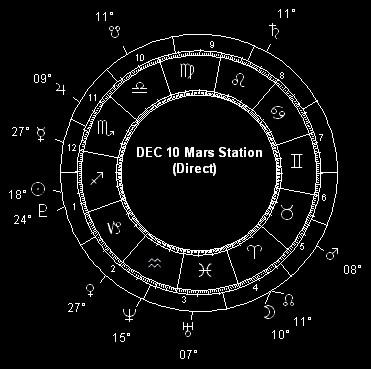 It's clear what happened last time: volcanic winter, with unusually low temperatures and snow in the summer; floods in arid regions; crop failures and stunted tree growth (the latter documented by tree ring studies). Volcanologist Ken Wohletz has reviewed the geological evidence and concludes that the Dark Ages and indeed a whole historic shift in global human civilization were triggered by a volcanic eruption (where Krakatoa is now) in 535, which initiated a cycle of global cooling on the order of "5 to 10 degrees C or more lasting over 10 to 20 years," (followed by) "subsequent global warming with remaining water vapor acting as a greenhouse gas and decreased ozone."
It's clear what happened last time: volcanic winter, with unusually low temperatures and snow in the summer; floods in arid regions; crop failures and stunted tree growth (the latter documented by tree ring studies). Volcanologist Ken Wohletz has reviewed the geological evidence and concludes that the Dark Ages and indeed a whole historic shift in global human civilization were triggered by a volcanic eruption (where Krakatoa is now) in 535, which initiated a cycle of global cooling on the order of "5 to 10 degrees C or more lasting over 10 to 20 years," (followed by) "subsequent global warming with remaining water vapor acting as a greenhouse gas and decreased ozone."
The current T-square is still forming up, and the December 17 Jupiter-Saturn square (within a degree of exact from the 12th through the 21st) is only the next part of the pattern sliding into place. To be sure, it's emphasized by the Mars opposition to Jupiter on the 5th (within a degree from the 1st through the 9th), the Mars direct station at 8° Taurus on the 10th, and the Mars square to Saturn on the 28th (within a degree's orb from 23rd through the 31st); also by the Venus retrograde station at 1° Aquarius on the 24th. Still, despite all this activation, don't look for the world to change overnight this month. Instead, look for more pieces of the puzzle to come forth.
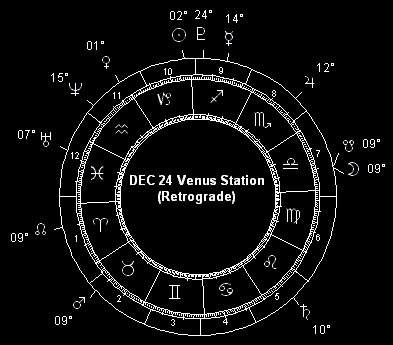 The December 17 configuration is the first quadrature of Jupiter and Saturn since the epochal conjunction in Taurus back in 2000. It will be repeated, due to retrogrades, in June and October of 2006. This will be the first "three-peat" Jupiter-Saturn waxing square since the 1945-1946 triplet (the third instance of which was also in the Scorpio-Leo sign pairing).
The December 17 configuration is the first quadrature of Jupiter and Saturn since the epochal conjunction in Taurus back in 2000. It will be repeated, due to retrogrades, in June and October of 2006. This will be the first "three-peat" Jupiter-Saturn waxing square since the 1945-1946 triplet (the third instance of which was also in the Scorpio-Leo sign pairing).
Any Jupiter-Saturn square represents a critical moment of social, cultural, economic and political change. It's a time when ideology and reality, theory and practice are so out of balance that a readjustment is not only inevitable, but almost easy - even if the medicine tastes awful going down. Certainly this will be played out in American politics, and in international relations as well: tensions and conflicts won't disappear, but adjustments will be made so that the stalemates of 2004 will grudgingly turn into progress in 2005. Some developments in this direction have occurred recently, including movement toward a US withdrawal from Iraq, tentative moves by the Sunnis to get into the government of a new Iraq, a hint of a resolution of the Iran nuclear crisis, and the formation of a coalition government in Germany (to name a few examples).
I'm not saying that Iraq won't still be a bloody mess and a huge problem for the US. This month's Mars-Saturn square is a sign that things get a whole lot worse on the bloody mess front, before they get any better. Mars remains huge in the sky this month, but begins to fade after its direct station on the 10th, so the long run of violence and conflict is starting to wind down for now. Until it does, remember: from collective violence like war to individual violence like murder and other criminality (and including that strange twilight, terrorism), from accidents and crashes and fires and explosions due to recklessness or evil intent and sometimes just plain bad luck, December is yet another adrenalin surging month. If you sense angst and impatience in yourself and others, don't be alarmed: it's par for the course when Mars is so prominent. Get a grip, calm yourself as much as possible, keep focused on what you're doing and watch out for interference (or worse). Be ready to dodge danger, and for heaven's sake don't go where you're likely to find it unless you're just bound and determined for trouble.
The Jupiter-Saturn square signals movement in the direction of breaking up impasses of the social, political, economic and cultural fronts. It's not the kind that one side imposes on the other, but one that each side settles for because it can't force the issue its own way. Think of the 1945-1946 stalemate between the US and Russia. In the aftermath of the 1945-1946 triple Jupiter-Saturn waxing square, two ideological foes who had become allies of convenience, found themselves face to face and armed to the teeth once their common enemies had been defeated. Neither had the strength or resolve to defeat the other in outright conflict, so they settled into what came to be called the Cold War. There's another Cold War brewing again, now that the triple waxing Jupiter-Saturn square has returned: an uneasy, probing confrontation and adaptation, rather than outright overt conflict. In domestic politics, in international relations, in the clash of civilizations, it's a Cold War brewing.

Last but not least, there's the economic element of this adjustment. It will be hugely central to what happens, given the conjunction in Taurus which started the current Jupiter-Saturn cycle back in 2000; plus Jupiter's presence now in Scorpio (the sign opposite Taurus). December's combination of configurations involving Jupiter and Saturn with stations of Mars and Venus in Taurus and Aquarius respectively adds to the emphasis on structural change in the world financial system - a system which dates back, arguably, to the last triple conjunction of Jupiter and Saturn in Taurus in the 1940s; which, incidentally, was the first such triple conjunction since the one in 562-561 BCE. Interesting coincidence: the current world financial system dates back to the establishment of the US dollar as the global reserve currency back in the 1940s, while history records the first use of gold coinage as an innovation by King Croesus, ruler of Lydia from 560 to 546 BCE. Suggestion: buying gold and silver bullion coins whenever there's a price dip might just make a person, as the saying goes, "rich as Croesus."
 SPECIAL FEATURE: This month's birthdays of the famous and infamous (with astrological birth charts)
SPECIAL FEATURE: This month's birthdays of the famous and infamous (with astrological birth charts)